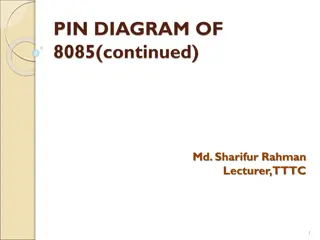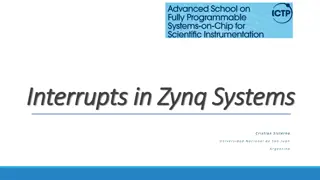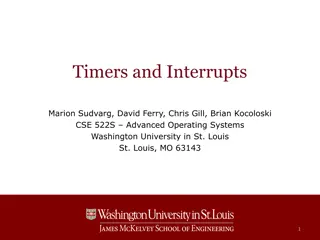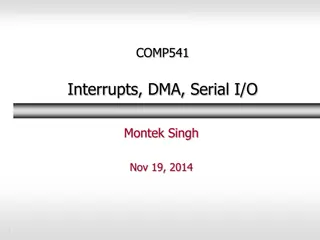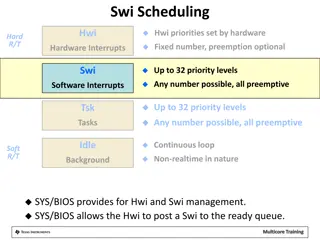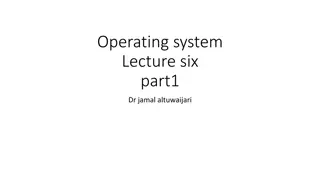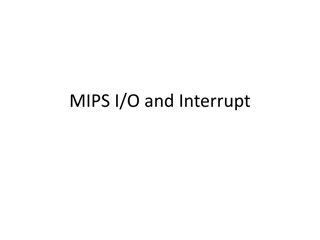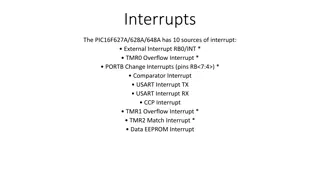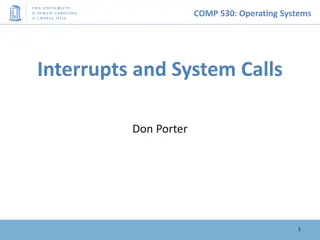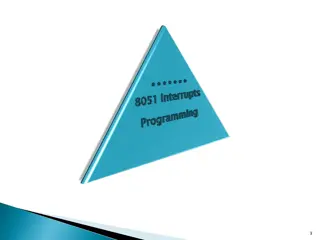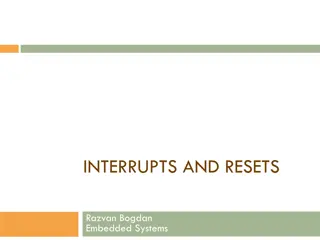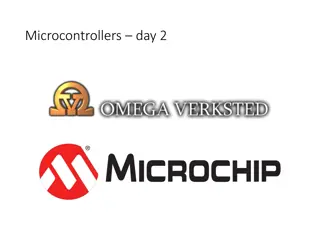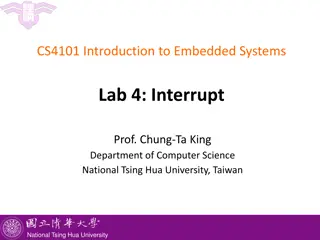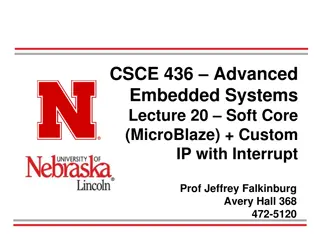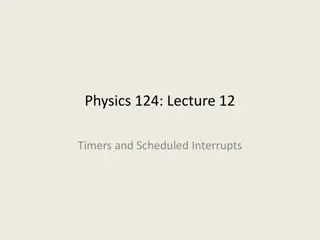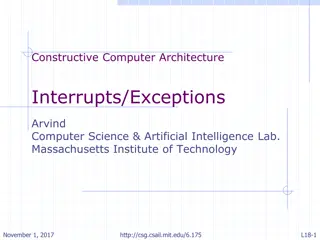
Interrupt Handling and Scheduling in CS 4411 Spring 2020
Explore project 2 on interrupts, scheduling, and privilege modes in CS 4411 Spring 2020. Learn about arrays, stacks, memory allocation, and compare arrays to stacks. Dive into the basics of project 2, interrupt handling, and scheduling using round-robin and multi-level feedback queue algorithms.
Download Presentation

Please find below an Image/Link to download the presentation.
The content on the website is provided AS IS for your information and personal use only. It may not be sold, licensed, or shared on other websites without obtaining consent from the author. If you encounter any issues during the download, it is possible that the publisher has removed the file from their server.
You are allowed to download the files provided on this website for personal or commercial use, subject to the condition that they are used lawfully. All files are the property of their respective owners.
The content on the website is provided AS IS for your information and personal use only. It may not be sold, licensed, or shared on other websites without obtaining consent from the author.
E N D
Presentation Transcript
Project 2, Interrupts, and Scheduling CS 4411 Spring 2020
Announcements Office hours Regrades Piazza
Outline for Today Arrays and Stacks Project 2 Overview Interrupt Handling Privilege Modes Timer Interrupts Scheduling with Quanta
On P1: A Note About Stacks 0xFFFFFFFF Standard process layout: Stack grows downward What does this mean? push instruction: Decrements SP Stores register to memory at SP pop instruction: Reads memory at SP into register Increments SP Kernel pop Stack SP push Heap Virtual addresses Data Code 0x00000000
Compare to Arrays Arrays in C are contiguous memory Array index is really pointer addition Array variable is a pointer to first element arr + 3 * sizeof(int) int[4] arr; arr[o] arr[1] arr[2] arr[3] arr 0x6FAA00 0x6FAA00 0x6FAA04 0x6FAA08 0x6FAA0C 0x6FAA10
Arrays vs. Stacks arr int[4] arr; arr[o] arr[1] arr[2] arr[3] 0x6FAA00 0x6FAA04 0x6FAA08 0x6FAA0C 0x6FAA10 Register 4 Register 3 Register 2 Register 1 stack push sp
malloc() Behavior malloc() is a natural fit for arrays: it returns a pointer to the lowest memory address in the allocated region int* arr = malloc(4 * sizeof(int)); arr 0x6FAA00 0x6FAA00 0x6FAA10 Is this what you want for a thread/process s stack? (Can you use arr as a stack pointer?)
Outline Arrays and Stacks Project 2 Overview Interrupt Handling Privilege Modes Timer Interrupts Scheduling with Quanta
Project 2 Basics EGOS has a scheduler, but it s not very good Round-robin algorithm FIFO run queue, timer interrupts force yield Replace scheduling logic with Multi-Level Feedback Queue Measure quality of new scheduler Each process s completion time and number of yields Overall average CPU load
Project 2 Logistics One file to edit: src/grass/process.c When you make changes, keep the original code, and use a macro to select whether new or old code is compiled: #ifdef HW_MLFQ proc_next = mlfq_get_next(&run_queue, level); #else proc_next = queue_get(&proc_runnable); #endif If COMMONFLAGS in Makefile.common includes -DHW_MLFQ your code will be used, otherwise original code will be used Your new code Original (round- robin) code
Concepts in Project 2 Interrupt handling Context switches (again) Process blocking and I/O Scheduling decisions and bookkeeping
Outline Arrays and Stacks Project 2 Overview Interrupt Handling Privilege Modes Timer Interrupts Scheduling with Quanta
Essentials of Interrupt Handling Hardware-assisted Interrupt Vector selects where CPU jumps In a fixed, known location, has an entry for each type of interrupt Forced context switch IV Interrupt Interrupt Controller CPU Program Signals Interrupt Handler Devices Memory
Privileges Interrupt handling is a privileged operation HW sets kernel-mode bit Interrupt handlers are part of kernel After interrupt handler runs, return control to user process User process User process User mode Kernel mode Keyboard interrupt handler Disk interrupt handler
Memory Layout When interrupt happens, some other process is running To switch to interrupt handler, kernel memory must also be mapped in process s address space Otherwise, how would you get to interrupt handler s code? Kernel Stack SP PC Heap Data Code
Memory Layout Interrupt handler is a program, needs a stack Where should its stack be? Kernel, in privileged mode, has access to process s entire memory space Kernel Kernel stack Stack SP PC Each process has a kernel stack SP moved here every time kernel takes control E.g. when interrupt handler is running Heap Data Code
Interrupt Handling in EGOS Interrupts generated by intr module in Earth (src/earth/intr.c) Simulates interrupt controller Kernel registers an interrupt handler that calls proc_got_interrupt() in process.c for all interrupts Interrupts disabled (masked) by default in kernel mode Interrupts only enabled: When executing user-mode process When waiting for I/O (even in kernel mode) Masked interrupts will fire once interrupts re-enabled
A Special Kind of Interrupt Other Types of Interrupts I/O Interrupts Device has some input for you! Page Fault Interrupts Process needs memory! System Calls Process wants you to do something! Timer Interrupts Ding! Time has elapsed! No pending task to do What s the point? Periodically returns control to the kernel, even for long- running processes Kernel can switch to a different process pre-emption
Outline Arrays and Stacks Project 2 Overview Interrupt Handling Privilege Modes Timer Interrupts Scheduling with Quanta
Reasons for Scheduling Why might control return to the kernel? A timer interrupt occurred Another kind of interrupt occurred (I/O, system call, etc) Process is blocked waiting for an event Process has terminated Which of these requires the kernel to schedule a new process?
A Day in the Life Process 2 P 2 Disk Process 1 Process 1 User mode interrupt Timer read() syscall Kernel mode interrupt Timer interrupt handler System call routine Disk interrupt handler
Quanta and Scheduling Quantum = arbitrary unit (of time) In a scheduler, quantum = maximum time a process can execute Round Robin with 10ms quantum: Process 1 P 1 P 1 Process 2 P 2 10ms P 3 P 3 Blocks and waits Time Blocks and waits I/O finally ready
Quanta and Clock Interrupts Timer (clock) interrupts are how the OS measures time Scheduler s quantum is a multiple of clock ticks Each timer interrupt is a clock tick P2 User mode P1 P1 P1 P1 P1 Kernel mode 1 2 3 4 5 Kernel s tick counter:
Round Robins Details Round Robin with 10ms quantum Timer interrupt (clock tick) every 2ms Timer interrupts Process 1 P 1 P 1 Process 2 P 2 10ms P 3 P 3 Syscall Syscall
On a Timer Interrupt Increment clock tick Determine if quantum is over If not, interrupted process should resume running Make scheduling decision In Multi-Level Feedback Queue, what happens when a process reaches the end of a quantum without blocking?

